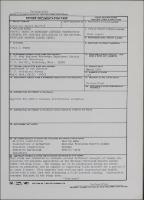Please use this identifier to cite or link to this item:
https://hdl.handle.net/11681/12749| Title: | Traffic tests of expedient airfield construction concepts for possible application in the National Petroleum Reserve Alaska (NPRA) |
| Authors: | Geological Survey (U.S.) Burns, Cecil D. |
| Keywords: | Airfield construction Landing mats Construction in permafrost National Petroleum Reserve Alaska Expedient construction Runways Expedient surfacings Traffic tests Insulation Cold weather conditions Construction Permafrost Frozen ground Frozen soils |
| Publisher: | Geotechnical Laboratory (U.S.) Engineer Research and Development Center (U.S.) |
| Series/Report no.: | Technical report (U.S. Army Engineer Waterways Experiment Station) ; GL-79-2. |
| Description: | Technical Report Abstract: This study was conducted to evaluate several different concepts of runway construction for possible application at the National Petroleum Reserve Alaska (NPRA) drilling sites. The runways are to be constructed during the winter months on permafrost and be capable of supporting C-130 aircraft for a period of at least 2 years . Five separate test sections were constructed and traffic tested with a test load cart simulating a C-130 aircraft loading. Construction concepts included in the study were: a.) Prefabricated aluminum landing mat over Styrofoam insulation. b.) Gravel base course over Styrofoam insulation. c.) Gravel base over loosely placed saturated sand fill. d.) Sand- grid confinement fills. The significant finding from this study was that a landing mat or a good-quality, well-compacted gravel base, at least 15 in. thick, placed directly over a sufficient thickness of 60-psi Styrofoam insulation material to prevent thaw in the frozen subgrade will provide a satisfactory runway for C-130 aircraft operation. |
| Rights: | Approved for public release; distribution is unlimited. |
| URI: | http://hdl.handle.net/11681/12749 |
| Appears in Collections: | Technical Report |
Files in This Item:
| File | Description | Size | Format | |
|---|---|---|---|---|
| TR-GL-79-2.pdf | 12.87 MB | Adobe PDF |  View/Open |